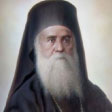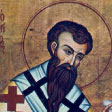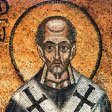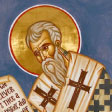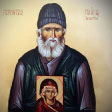Saint Gregory of Nazianzus
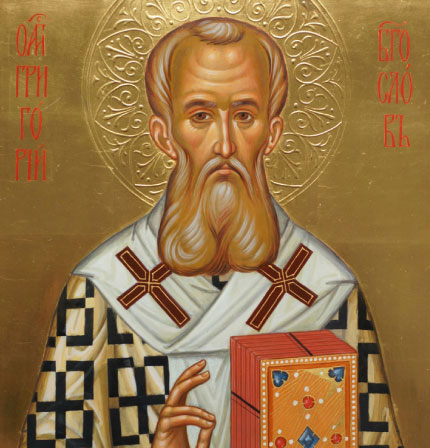
The Life and Ministry of Saint Gregory of Nazianzus
Saint Gregory of Nazianzus, known as “The Theologian,” stands among the most revered figures in the history of the Church. His life, marked by deep devotion to God, brilliant theological insight, and poetic eloquence, secured his place as one of the Cappadocian Fathers alongside Saint Basil the Great and Saint Gregory of Nyssa. Gregory’s writings, particularly his reflections on the Holy Trinity, continue to shape the contours of Orthodox theology. His legacy endures as both a defender of Nicene orthodoxy and a contemplative voice calling the faithful to deeper communion with the mysteries of God.
Early Life and Education
Gregory was born around 329 AD in the village of Arianzus near Nazianzus, in Cappadocia (modern-day Turkey). His parents, Gregory the Elder and Nonna, were devout Christians who nurtured their son in the faith. Gregory the Elder later became the bishop of Nazianzus, and his mother is venerated as a saint, reflecting the sanctity that pervaded their household.
Gregory’s early education was extensive and refined. He studied in the renowned centers of learning – first in Caesarea, then in Alexandria, and finally in Athens. It was in Athens that Gregory formed a lifelong friendship with Saint Basil the Great, a relationship that would profoundly shape both their lives and the future of the Church. The two studied together, pursuing philosophy, rhetoric, and classical literature. Yet, for Gregory, this education was not an end in itself but a preparation for his service to the Church.
During his time in Athens, Gregory was deeply drawn to the ascetic life. His heart longed for the tranquility of monasticism and contemplative prayer. However, God’s providence would repeatedly call him from the solitude he cherished into the tumult of ecclesiastical and theological strife.eluctant Ministry and Ordination
Upon returning to Nazianzus, Gregory was reluctantly ordained a presbyter by his father around 361 AD. Gregory’s initial response was one of flight – he withdrew into seclusion, overwhelmed by the weight of pastoral responsibility. However, through prayer and reflection, he came to see his ministry as a participation in Christ’s own shepherding of the flock. In his later writings, Gregory would describe this internal struggle as part of the soul’s ascent toward God – a journey marked by the tension between divine calling and personal weakness.
In 372 AD, Basil, now Archbishop of Caesarea, appointed Gregory as the bishop of the small and contentious town of Sasima. This appointment was part of Basil’s strategy to fortify Nicene orthodoxy against the Arian forces backed by the imperial court. Gregory, however, found the posting intolerable, describing Sasima as a barren, inhospitable place filled with conflict. Although he never fully embraced his role there, Gregory’s loyalty to Basil and their shared vision for the Church kept him engaged in the struggle to defend the faith.
Theological Defense and the Second Ecumenical Council
The defining period of Gregory’s life began in 379 AD when he was called to Constantinople to lead the small Nicene Christian community amidst an overwhelmingly Arian population. Arianism, which denied the full divinity of Christ, dominated much of the Eastern Roman Empire. Gregory’s arrival marked the beginning of his most significant contribution to the Church – his defense of Trinitarian theology.
Gregory began his ministry in Constantinople preaching from a modest home that would later become known as the Church of the Resurrection. It was here that he delivered his famous Five Theological Orations – sermons that masterfully articulated the mystery of the Holy Trinity. Gregory’s orations defended the full divinity of the Son and the Holy Spirit, affirming that the Father, Son, and Spirit share one essence (homoousios) yet are distinct in personhood.
These sermons were not merely intellectual exercises but profound acts of worship, imbued with poetic beauty and contemplative depth. Gregory’s theology was not abstract; it flowed from his lived experience of God’s presence and his deep immersion in Scripture and prayer. He spoke of the Trinity not as a distant doctrine but as the living heart of the Christian faith – the source and goal of all creation.
In 381 AD, Gregory presided over the Second Ecumenical Council in Constantinople, convened by Emperor Theodosius I to reaffirm Nicene orthodoxy. Under Gregory’s leadership, the council expanded the Nicene Creed, clarifying the divinity of the Holy Spirit and fortifying the Church against Arianism and other heresies. However, Gregory’s tenure as president was short-lived. Ecclesiastical politics and factional disputes led him to resign, returning once more to the quiet life of contemplation he so dearly loved.
The Poet-Theologian
Gregory’s writings reflect a rare synthesis of theological depth and literary artistry. Known as the “Theologian” – a title reserved for only a few saints – Gregory approached theology not as a rigid system but as a living encounter with the mystery of God. His sermons, letters, and poems reveal a heart captivated by divine beauty.
In his theological poetry, Gregory expresses the ineffable nature of God, often weaving together personal reflection, scriptural exegesis, and liturgical praise. His poetry touches on themes of divine light, the soul’s ascent, and the paradox of suffering and grace. Gregory’s works not only defend the faith but invite the reader into the transformative experience of God’s presence.
One of Gregory’s most poignant poems reflects his longing for the contemplative life: "Flee, my soul, from the earth to the heavens; Flee from the world and find your home in God; There alone will you find rest and joy, Where the angels sing without ceasing."
This yearning for divine communion shaped Gregory’s entire ministry. Even amid the controversies and responsibilities of public life, his heart remained oriented toward the eternal.
Later Years and Legacy
After resigning from Constantinople, Gregory returned to Nazianzus, where he lived in relative seclusion. He spent his final years writing, meditating, and caring for the local Church. Gregory reposed in the Lord around 390 AD, leaving behind a legacy that profoundly shaped the trajectory of Christian thought.The Orthodox Church honors Gregory as one of the Three Holy Hierarchs, alongside Saint Basil the Great and Saint John Chrysostom. His feast day is celebrated on January 25, and his influence continues to resonate in the Church’s liturgical prayers and theological reflections.
Spiritual Lessons from Saint Gregory
Saint Gregory of Nazianzus stands as a model of humility, faithfulness, and theological insight. His life reminds us that the path to holiness often involves struggle, sacrifice, and the willingness to embrace both contemplation and action. Gregory’s unwavering defense of the Trinity calls us to cherish the mysteries of the faith, not as abstract ideas but as encounters with the living God.
In honoring Saint Gregory, we are invited to ascend with him toward the divine light – to behold, even in part, the uncreated beauty that draws all creation into eternal communion with the Father, Son, and Holy Spirit.

